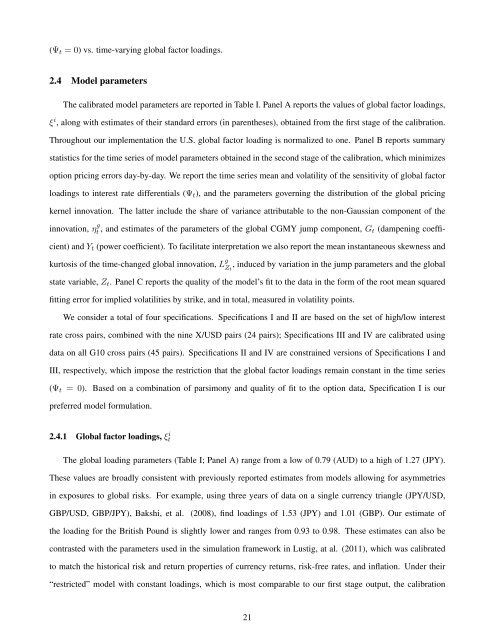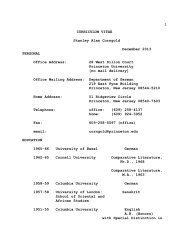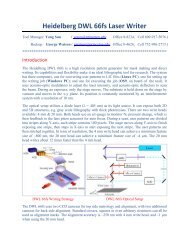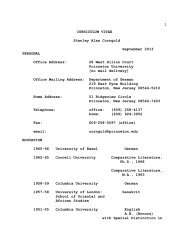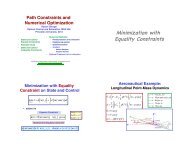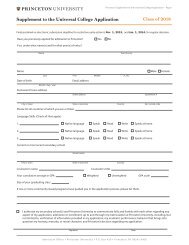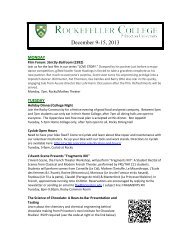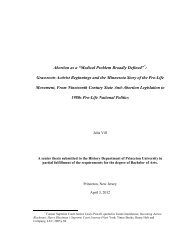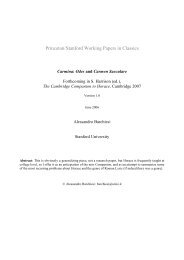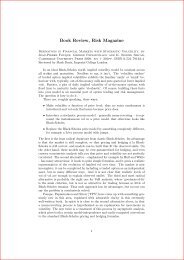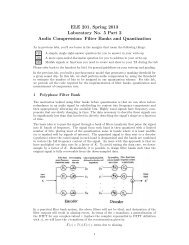Option-Implied Currency Risk Premia - Princeton University
Option-Implied Currency Risk Premia - Princeton University
Option-Implied Currency Risk Premia - Princeton University
You also want an ePaper? Increase the reach of your titles
YUMPU automatically turns print PDFs into web optimized ePapers that Google loves.
(Ψ t = 0) vs. time-varying global factor loadings.<br />
2.4 Model parameters<br />
The calibrated model parameters are reported in Table I. Panel A reports the values of global factor loadings,<br />
ξ i , along with estimates of their standard errors (in parentheses), obtained from the first stage of the calibration.<br />
Throughout our implementation the U.S. global factor loading is normalized to one. Panel B reports summary<br />
statistics for the time series of model parameters obtained in the second stage of the calibration, which minimizes<br />
option pricing errors day-by-day. We report the time series mean and volatility of the sensitivity of global factor<br />
loadings to interest rate differentials (Ψ t ), and the parameters governing the distribution of the global pricing<br />
kernel innovation. The latter include the share of variance attributable to the non-Gaussian component of the<br />
innovation, η g t , and estimates of the parameters of the global CGMY jump component, G t (dampening coefficient)<br />
and Y t (power coefficient). To facilitate interpretation we also report the mean instantaneous skewness and<br />
kurtosis of the time-changed global innovation, L g Z t<br />
, induced by variation in the jump parameters and the global<br />
state variable, Z t . Panel C reports the quality of the model’s fit to the data in the form of the root mean squared<br />
fitting error for implied volatilities by strike, and in total, measured in volatility points.<br />
We consider a total of four specifications. Specifications I and II are based on the set of high/low interest<br />
rate cross pairs, combined with the nine X/USD pairs (24 pairs); Specifications III and IV are calibrated using<br />
data on all G10 cross pairs (45 pairs). Specifications II and IV are constrained versions of Specifications I and<br />
III, respectively, which impose the restriction that the global factor loadings remain constant in the time series<br />
(Ψ t = 0). Based on a combination of parsimony and quality of fit to the option data, Specification I is our<br />
preferred model formulation.<br />
2.4.1 Global factor loadings, ξt<br />
i<br />
The global loading parameters (Table I; Panel A) range from a low of 0.79 (AUD) to a high of 1.27 (JPY).<br />
These values are broadly consistent with previously reported estimates from models allowing for asymmetries<br />
in exposures to global risks. For example, using three years of data on a single currency triangle (JPY/USD,<br />
GBP/USD, GBP/JPY), Bakshi, et al. (2008), find loadings of 1.53 (JPY) and 1.01 (GBP). Our estimate of<br />
the loading for the British Pound is slightly lower and ranges from 0.93 to 0.98. These estimates can also be<br />
contrasted with the parameters used in the simulation framework in Lustig, at al. (2011), which was calibrated<br />
to match the historical risk and return properties of currency returns, risk-free rates, and inflation. Under their<br />
“restricted” model with constant loadings, which is most comparable to our first stage output, the calibration<br />
21


